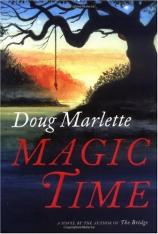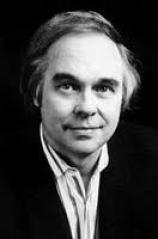Reading Group Guide
Discussion Questions
Magic Time: A Novel

1. Discuss the ironies in the novel’s title. What “magic” did Lige and his team of volunteers achieve? As a locale, what did Magic Time mean to all those who gathered there?
2. What was the effect of the author’s use of time lines? Why was it useful to intersperse the 1990s with memories of the 1960s? Does this technique mirror the way your own powerful memories seep into everyday life?
3. How does the E. B. White quote near the beginning of chapter two speak to Carter’s relationship to New York? How is his sense of identity linked to his sense of place?
4. When have you faced a homecoming similar to Carter’s and Stephen’s? What history is always tied to certain locations in your mind, regardless of how much time has passed?
5. What does the history contained in this novel—a fictionalized version of terrorist bombings in New York, and of bombings executed by white supremacists—indicate about the way violence has been witnessed in twentieth-century America? How was the SNCC able to gain power without violence?
6. What were the roots of the White Knights’ racism? Why did so many white supremacists believe they were “protecting” the country from communism? Does race camouflage money, as Carter says near the end of chapter twenty-two?
7. How were so many divergent groups able to unite around the cause of civil rights during the 1960s? What tensions between these groups were illustrated in the novel? At what point does Carter realize that remaining passive is morally unacceptable to him?
8. The parallels between Sarah and Emily are clear. What are the differences between them? Was Carter able to separate his memories of Sarah from his relationship with Emily? Do you agree with Emily’s assessment of him in chapter twenty-three? What makes Sydney an ideal match for him?
9. Though Magic Time is a work of fiction, it conveys the spirit of recent murder trials of white supremacists who were not brought to justice until three decades after their crimes were committed. In what ways does the book speak to your own knowledge or memories of headlines from this time period? How would you have responded to the cultural turmoil that marked Carter’s life forever? Why is fiction an important complement to journalism in capturing such events?
10. How did you react to the notion that the Ransoms formed Nettie’s “white family” (last paragraph of chapter nine)? What do you imagine was going through the mind of the African American man hired to tend to Bohannon? What enabled Lige to gain a career in politics, with a level of power never previously held by Troy’s black citizens?
11. One essential component of civil rights is a citizen’s access to a voting booth, a cause to which Sarah devoted tireless hours. Did volunteers such as Sarah succeed? Is the American voting system now free from injustice?
12. How does Lonnie’s background compare to Carter’s? In what way did fate versus willpower shape their futures? What ties, both tragic and triumphant, bind Carter to his boyhood friends?
13. What is the difference between the power brokers of Troy, such as Glen Boutwell, and the power brokers of New York, such as Marcy Tutweiler? Is status achieved through the same means, no matter where you go?
14. How did your impressions of Carter’s father evolve throughout the novel? How did you react to his brief affair with Sheppy? What does Hugh represent to the citizens of Troy, and eventually to Carter?
15. In chapter fifteen, we read the story behind Carter’s name and ancestry, as well as details about the judge’s war service. How do legacies shape the Ransom family? What did it mean to Carter that he was classified 4-F and therefore disqualified from service in Vietnam? What determines whether we follow or defy these legacies?
16. Discuss the factors in the trial that led to a conviction. What was needed to build a solid case? Besides jury selection procedures, what had changed in Troy’s judicial system during that thirty-year span?
17. How did Sarah’s family respond to Carter? How did his family respond to her?
18. During the chilling hostage scene in chapter twenty-seven, how did you react to the combination of humiliating poses and photographs used to evoke fear and degradation? How did you react to Hullender’s use of biblical quotations, particularly in light of Shiloh Church as the crime scene?
19. What do the novel’s closing events regarding Schlank indicate about new battles to wage, such as environmentalism? What tactics were ultimately successful in that case? What does the future hold for Sydney and Carter?
20. How might the author’s career as a leading editorial cartoonist shape his use of dialogue and imagery, and his overall approach as a novelist? What parallels did you discover between Magic Time and his previous novel, The Bridge?
Magic Time: A Novel
- Publication Date: October 3, 2006
- Hardcover: 496 pages
- Publisher: Farrar, Straus and Giroux
- ISBN-10: 0374200017
- ISBN-13: 9780374200015








